What Is Facebook Audience Overlap?
Facebook audience overlap is when two or more ads from a company’s campaign target the same person (or people) on the social media platform.
As an extreme example, imagine two ad sets where one targets people interested in marketing tools and the other targets people interested in SEO tools.
Most of the people in the second audience (the SEO tools one) will also be in the first audience (the general marketing tools one).
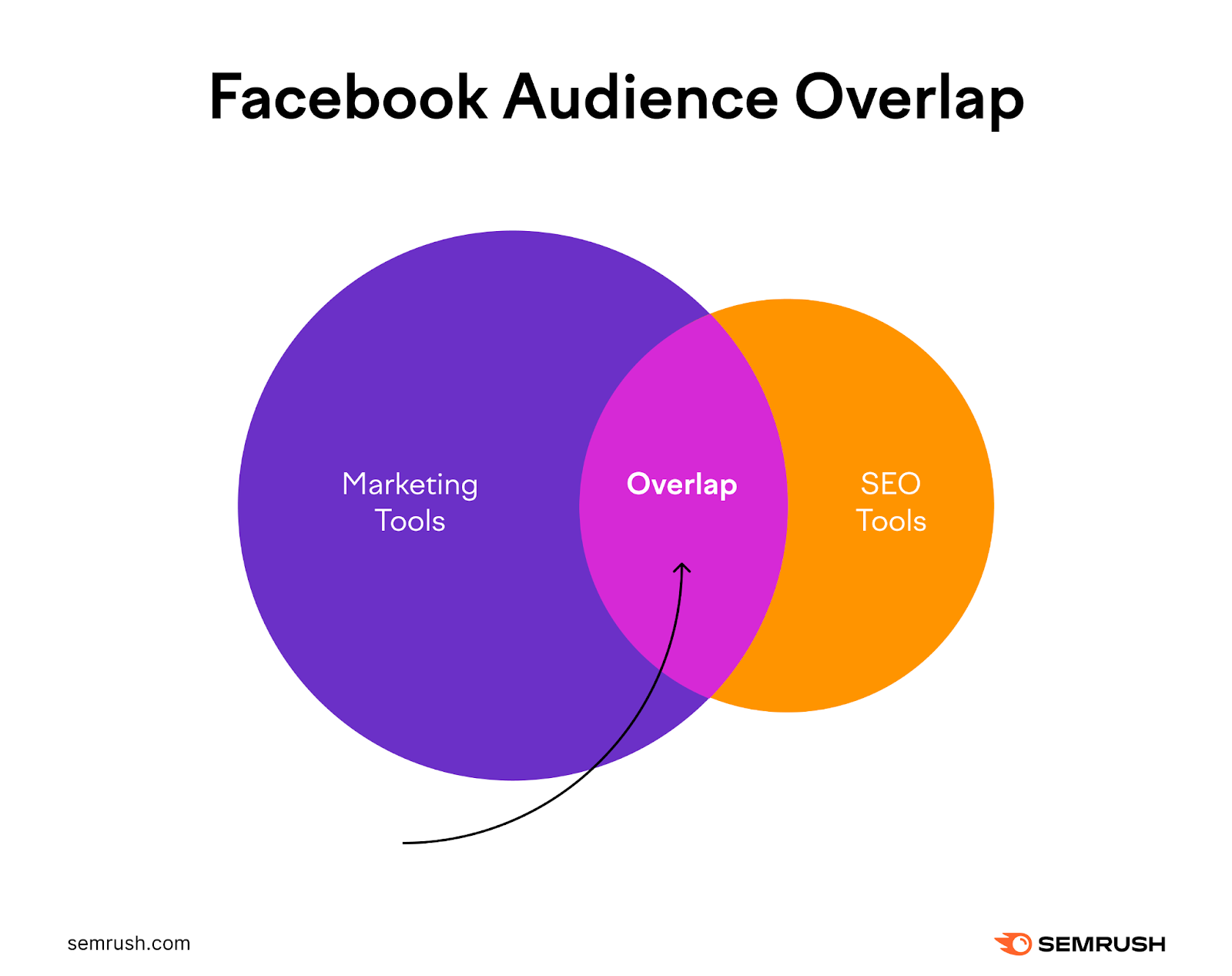
Facebook uses a behind-the-scenes auction to determine which ad to show every time there’s an opportunity. That means only one of your ads will get shown when there are two competing for the same audience.
Having only one ad show consistently will mean the other one may have reduced performance and be using the assigned budget inefficiently.
The Importance of Avoiding Facebook Audience Overlap
Steering clear of audience overlap means you don’t waste time and effort creating ads that are never shown, that never have a chance to perform well, and fail to use your assigned budget effectively.
Creating an ad that’s never shown can be frustrating. And it can also lead to misunderstandings about performance.
Why?
Because Facebook uses a “learning phase” for each new ad (or a heavily edited existing one) that involves various tests to ensure the best possible performance.
You can tell when an ad is in this phase by checking the “Delivery” column inside Meta Ads Manager:
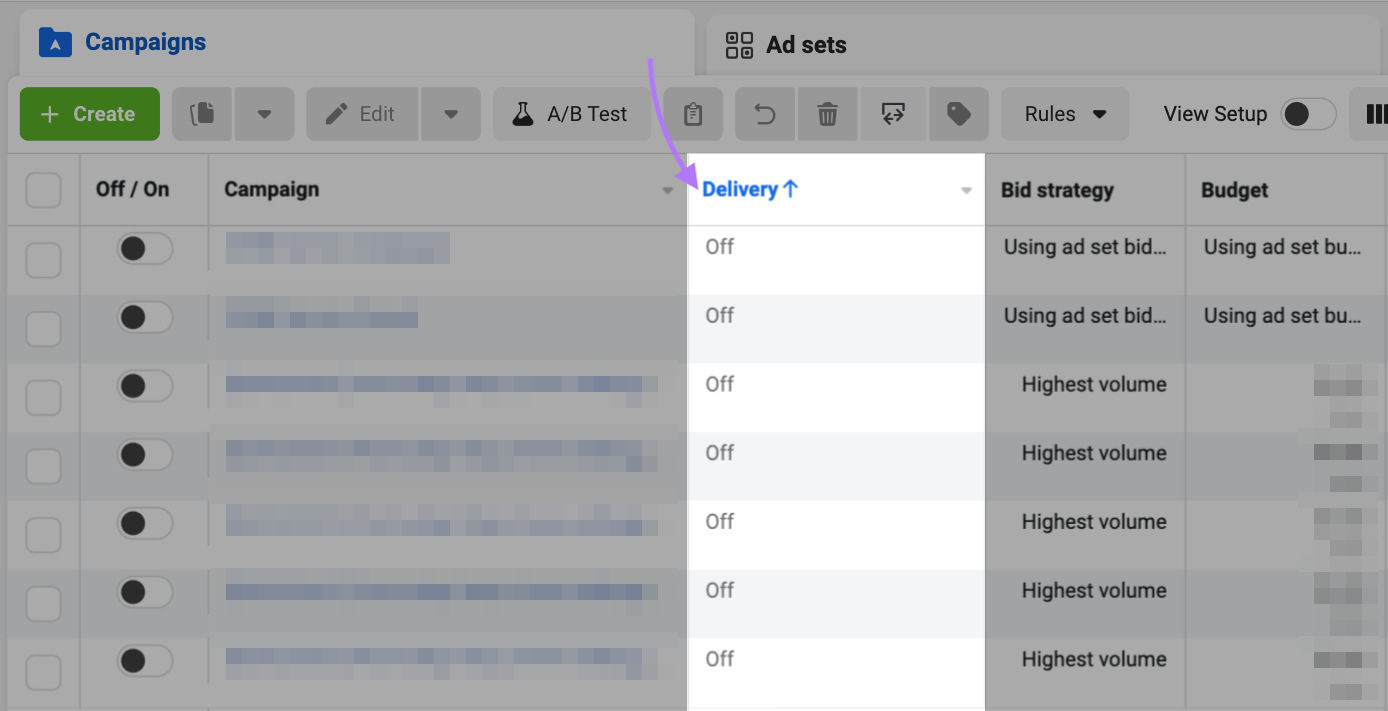
Because the platform is still experimenting, the ad’s performance is worse than average and the cost per action (CPA) is higher.
Usually, the learning phase concludes after the ad is shown to enough people for the performance to stabilize. But if the ad is shown infrequently or not at all, it enters the “learning limited” phase, indicating that the delivery system can’t optimize performance.
Plus, your budget might never get fully used.
And the overall return on investment (ROI) could be significantly worse. Because ads with overlapping audiences can spend more time in the higher-cost learning phase.
That means each dollar invested in a set or campaign with audience overlap is worth less than each dollar invested in a set or campaign without overlap.
Factors Contributing to Facebook Audience Overlap
Some audience overlap is inevitable. Because there are a limited number of potential customers for all businesses and some campaigns will target the same people.
So, you’ll have to evaluate campaigns on a case-by-case basis to ensure it doesn’t become problematic.
Tip: A good starting point is to evaluate the number of actions your ad receives against the size of the audience. Use previously successful campaigns as a benchmark to see if the ad is getting enough actions.
Here are the factors that contribute to too much overlap that you’ll want to keep an eye on:
Inadequate Audience Research
Poor audience research can lead to many bad outcomes, but many of them stem from the audience being too wide. Several ad sets with overly broad audiences may lead to overlap.
For example, you may be selling a supplement intended for gaming enthusiasts.
But targeting people with the interest of “gaming” won’t be enough. Because not all gamers are interested in supplements.
You may need to add demographic data (such as age and gender) and psychographic data (such as interests and opinions) to target your true audience effectively.
You can use Semrush’s Market Explorer to research your target audience.
Go to the tool, click on “Analyze Category,” and select your category from the “Business Category” drop-down menu. We’ll be choosing “Computer & Video Games”.
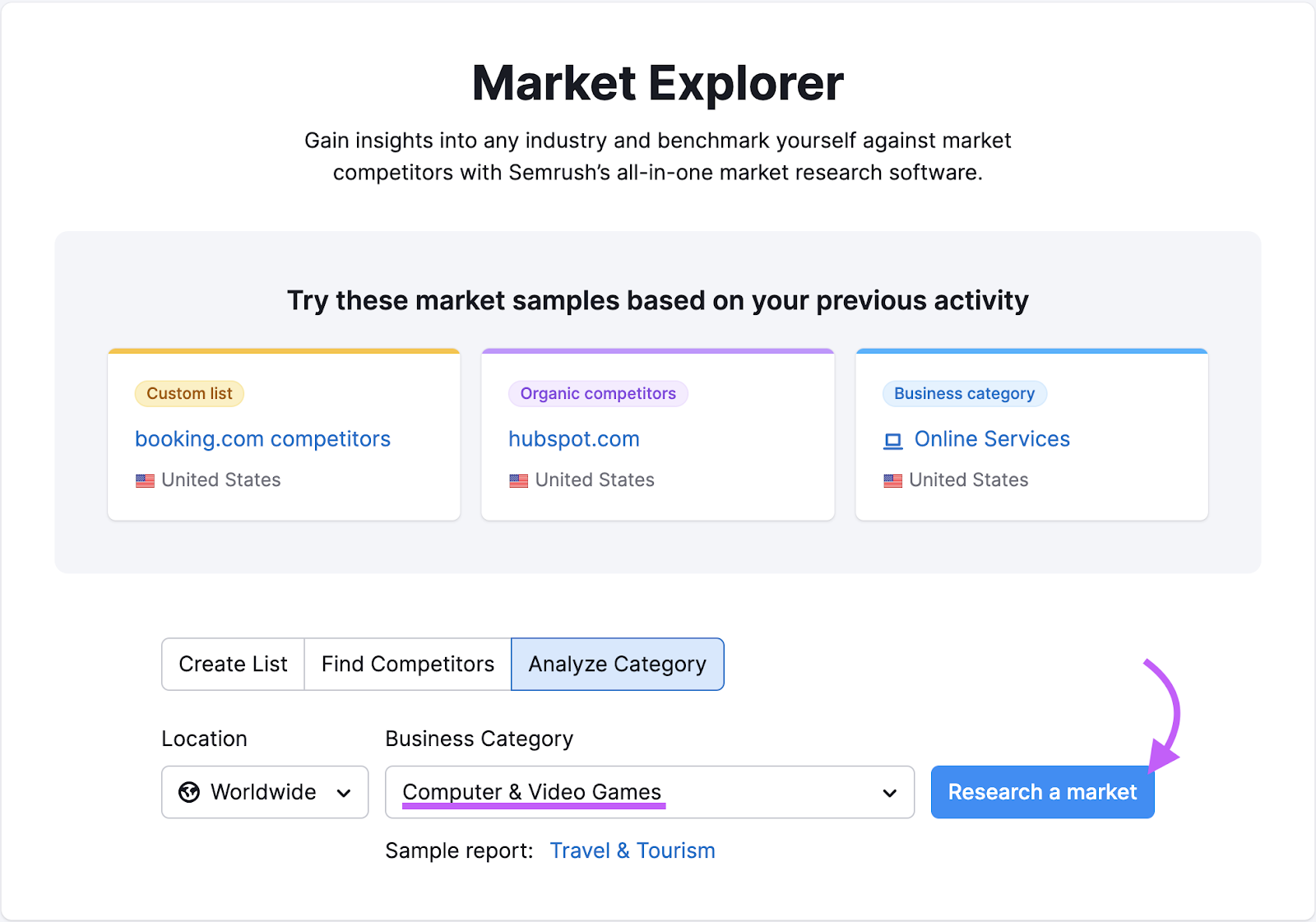
Then, click on “Research a market.” And you’ll be taken to the “Overview” report. Which will give you a high-level representation of the market.

Click on the “Audience” tab to get a more detailed demographic and interest data.
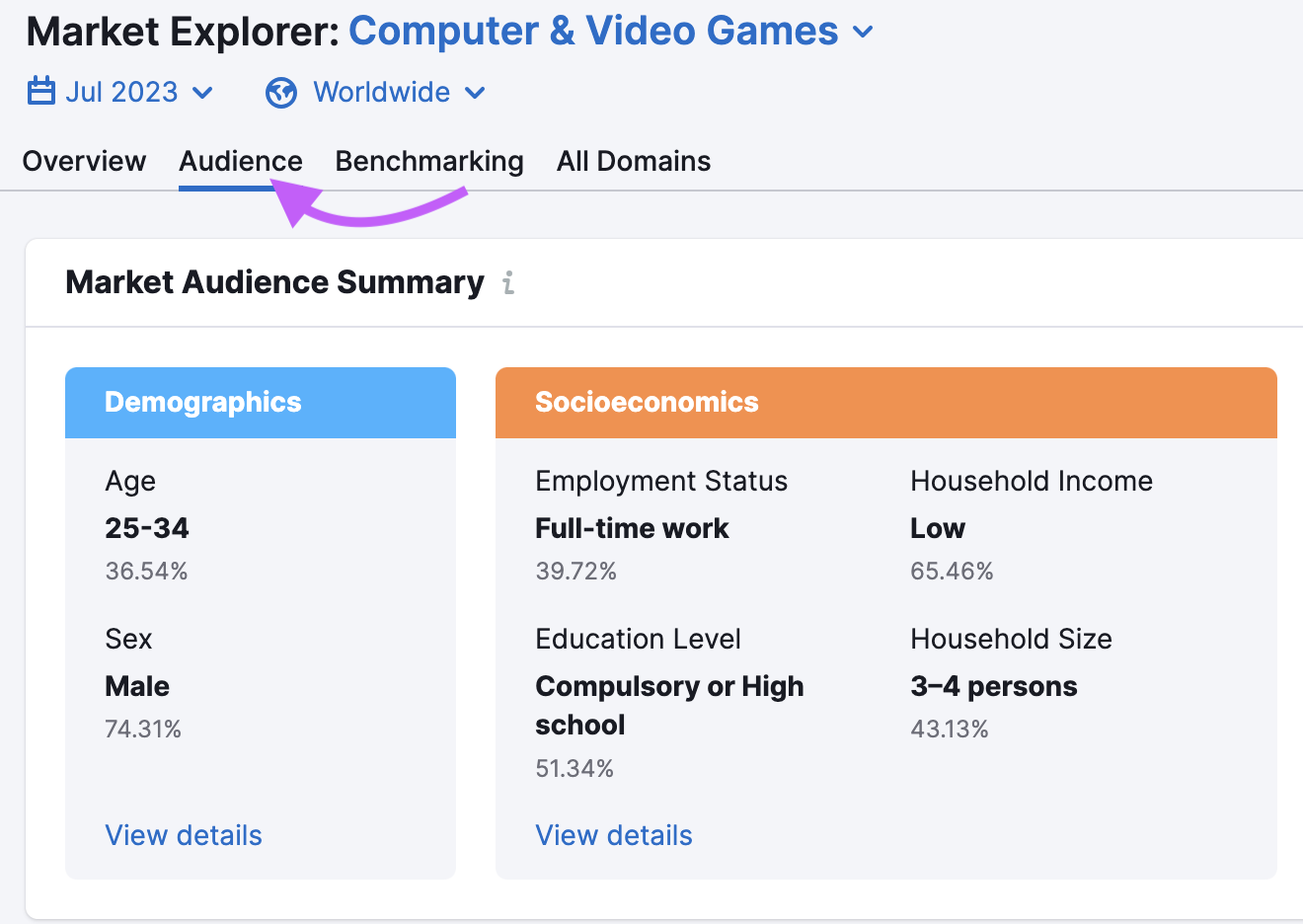
Finally, Facebook provides a dedicated solution to make research easier: lookalike audiences. These require you to have set up a custom audience. Which can be created based on your website visitors, customer lists, app activity data, or people who’ve engaged with your ads previously.
Using the custom audience as the source, Meta’s algorithms will look for people with similar demographics, interests, and behaviors to find new potential customers for your business.
Lookalike audiences are essentially automated audience research.
Poor Audience Segmentation
Proper audience segmentation is a balancing act. You don’t want to be so broad that you’re focusing on the wrong people or so narrow that you miss out on opportunities.
It’s challenging because of how many targeting options there are:
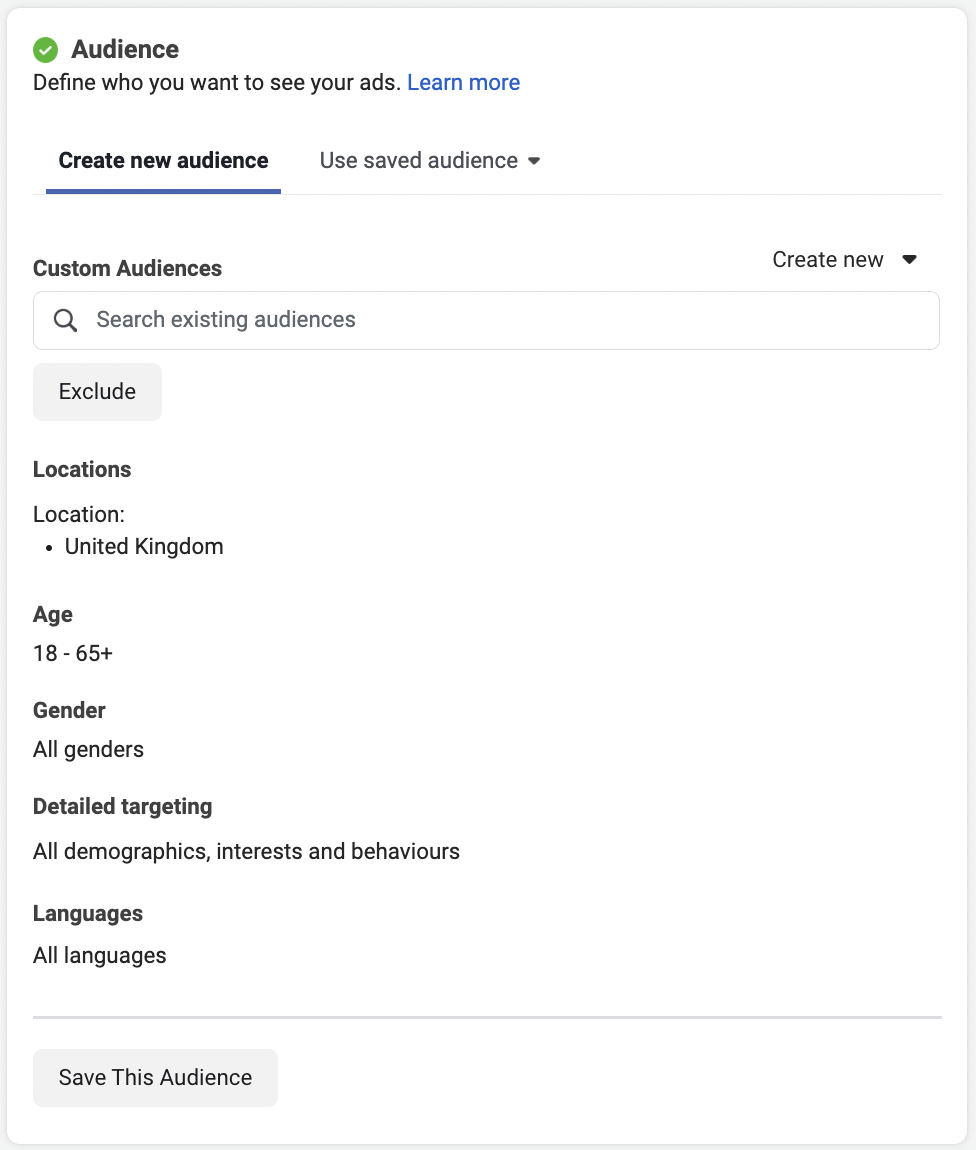
Marketers usually make the mistake of using targeting that’s too broad to err on the safe side.
They might use wide demographic ranges, define interests through far-reaching umbrella terms (e.g., “technology” over “game consoles”), or use all available ad placement options to make sure at least some of them are effective.
Improper Ad Set Configurations
A small budget and improper objectives don’t cause overlap. But they can exacerbate overlap issues.
Ads with significant overlap will spend more time in the learning phase where bid costs are higher, making budget issues more pronounced. Objectives will also influence learning phase time. And affect how much damage the overlap can cause.
And having too small of a budget can cause the ad set to have lower overall value due to reduced bid size. Because a lower bid size means winning fewer auctions. Which causes the ad to be shown less frequently.
Selecting certain objectives (see the list of options below) can also influence the impact an overlap has.
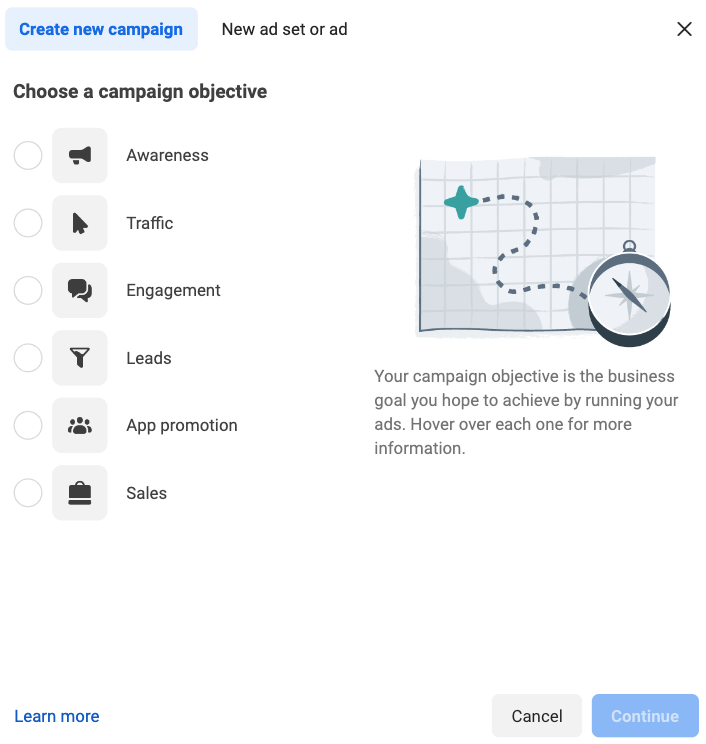
For example, an awareness objective will be less affected by overlap because the ad will eventually be shown to some number of people. And seeing the advertisement is the end goal.
But ads with the lead objective tend to spend longer periods of time in the learning phase since that objective requires people to interact with the ad. And only a small portion of people who’ve seen the ad will interact with it.
How to Access Facebook Audience Overlap Insights
Facebook provides an audience overlap analysis tool that makes it easy for marketers to detect whether issues are likely to arise.
You can find Facebook’s audience overlap tool by following these steps:
1. Go to Your Audience Page
Go to your Meta Ads Manager page. On the left-hand side of the screen, click on the “Audiences” button.
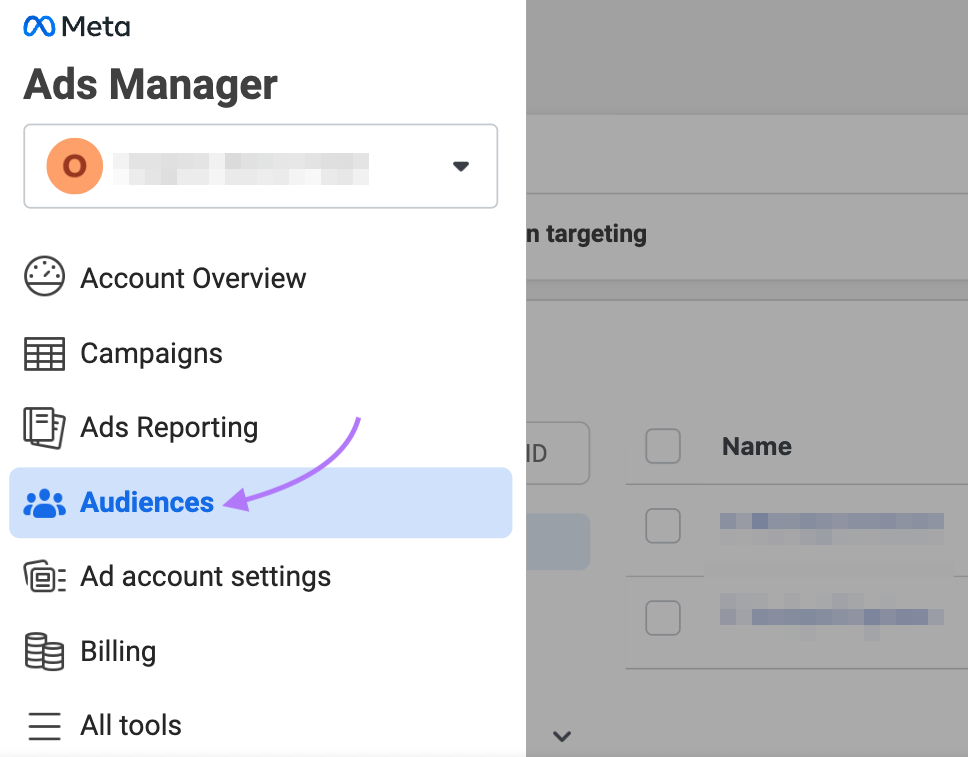
2. Select Your Audiences
You’ll likely see a couple of audiences on the main screen.
Select the ones you want to check for overlap.
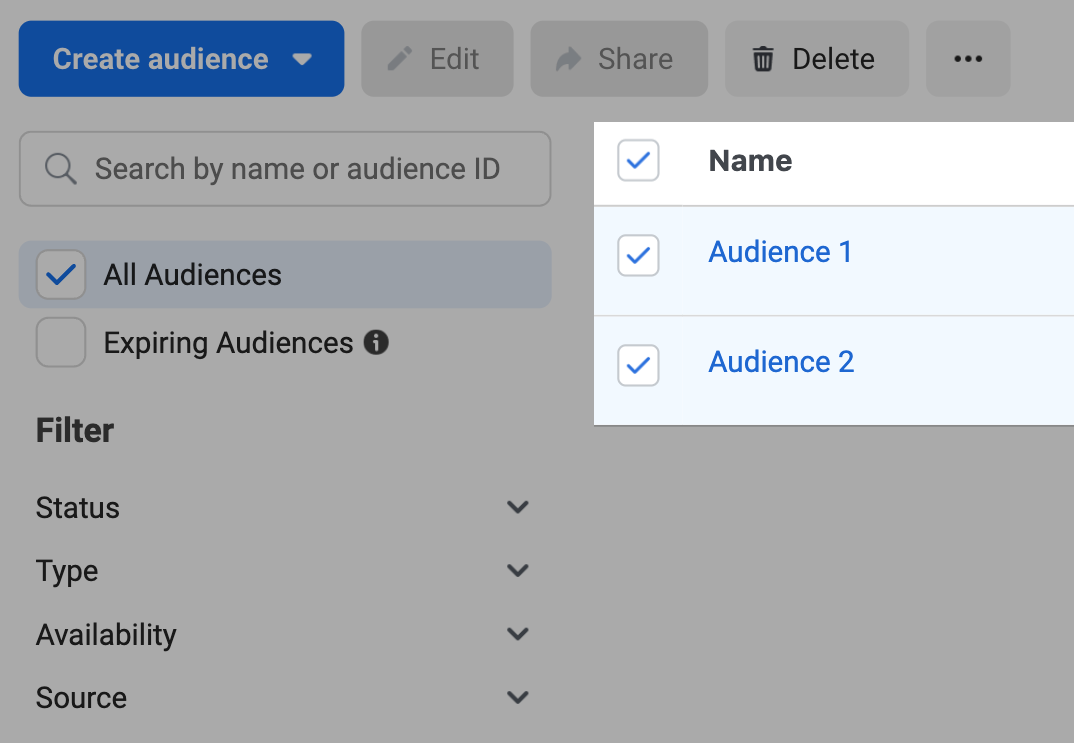
Find the ad campaign that you think is underperforming and compare it with others that target audiences with similar demographics, interests, or behaviors.
You might want to start by comparing two ad sets or campaigns with identical objectives. Because they’ll likely have a fair amount of overlap.
Note: Audience selection order matters. Facebook will match all other audiences against the first one you selected. So, the ratios and percentages will be calculated accordingly.
3. Open the Audience Overlap Tool
Once you’ve selected a few audiences, click on the three dots to the right of the “Delete” button.
A drop-down menu will open and the “Show Audience Overlap” option will become visible.
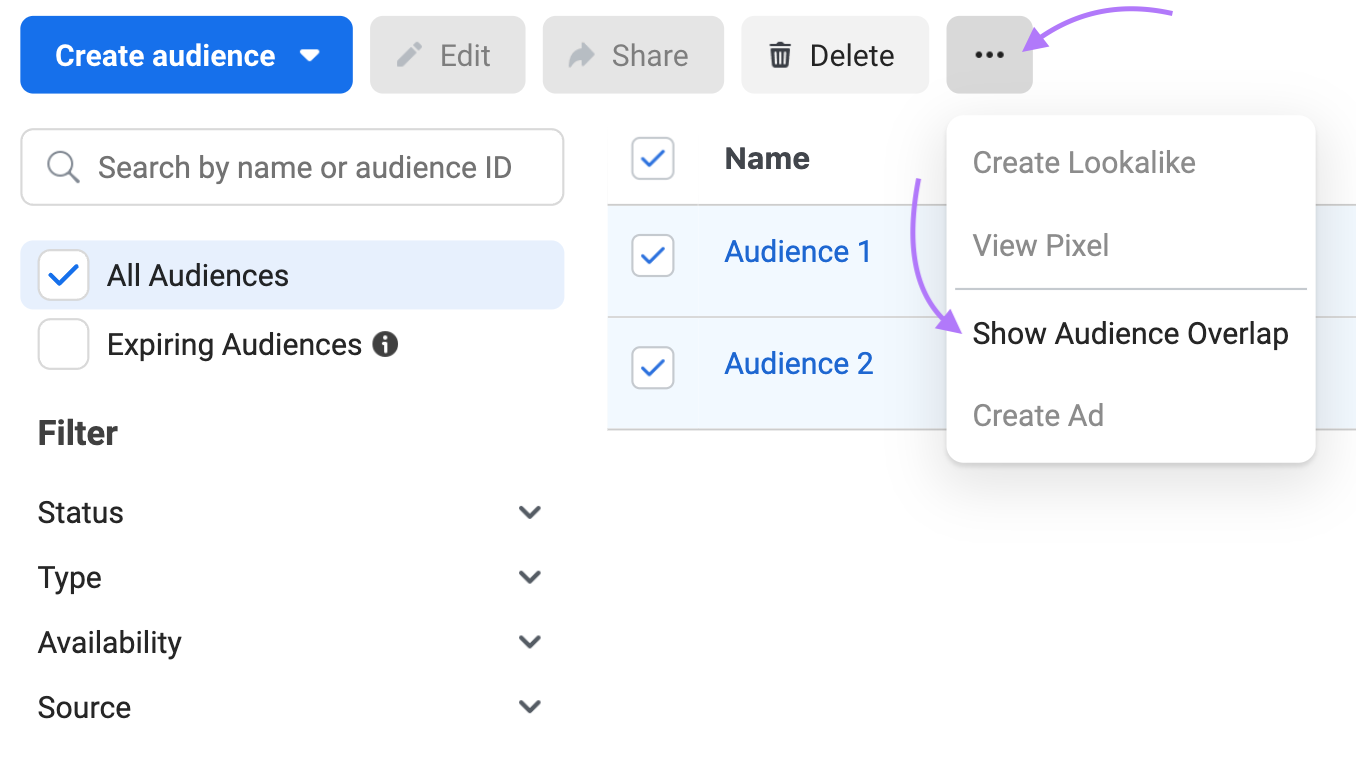
Click on the button to compare the selected audiences and see how much they overlap.
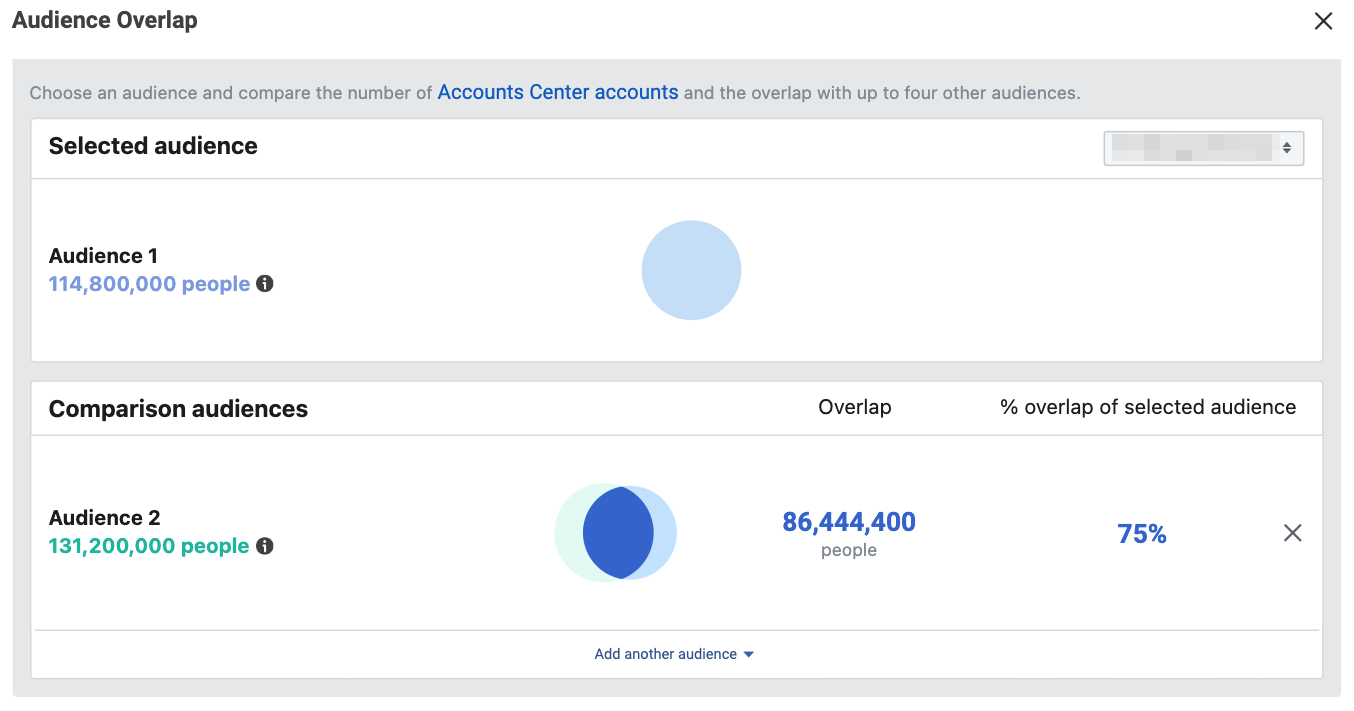
How to Interpret Audience Overlap Metrics
You only need to evaluate two metrics to understand the impact of your overlapping audiences:
- Audience size
- Overlap percentage.
Audience size is defined as the number of active accounts that fall within your designated ad settings. You can adjust demographics, locations, behavior, interest, and much more to change the size of an audience.
The overlap percentage shows the percentage of accounts that fall under two audiences.
Don’t get too invested in the numbers. Because these overlap metrics aren’t meaningful by themselves.
Treat audience overlap as a potential issue when something goes wrong. Not an indicator that something will go wrong. Especially if the overlap is relatively small like in the image below:
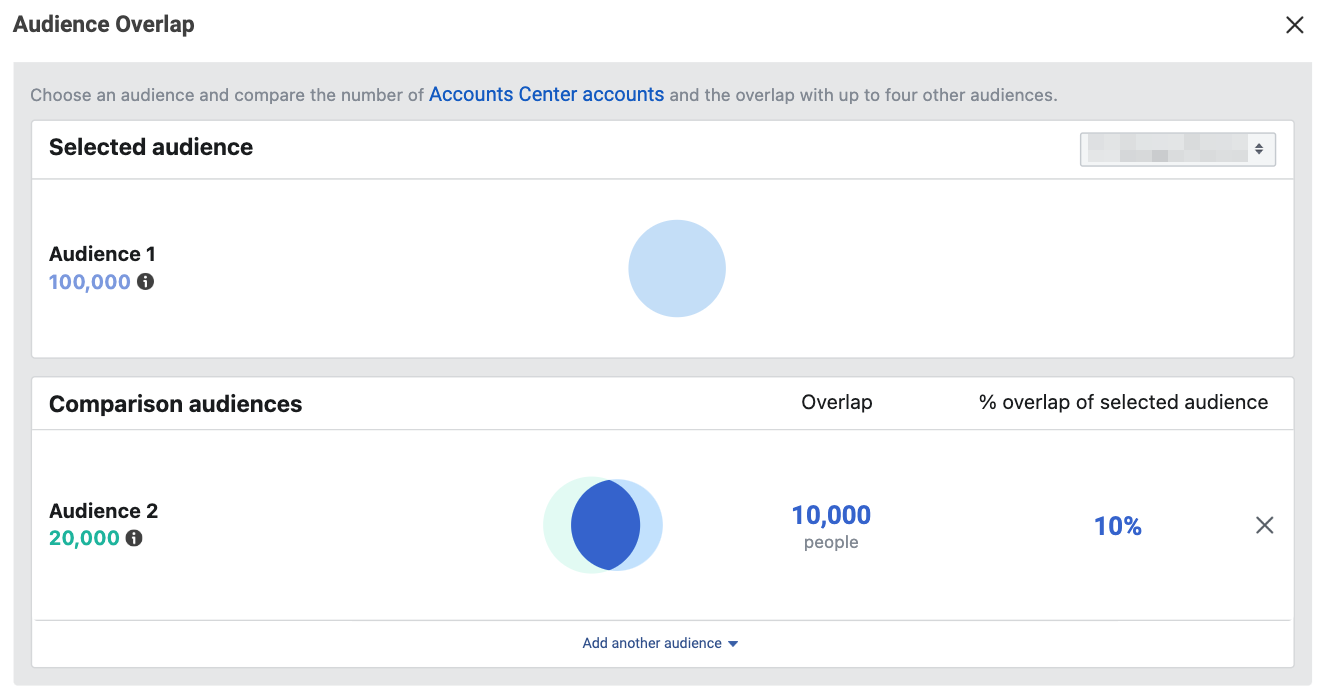
For example, let’s say one of your ad sets is having trouble moving out of the learning phase. That’s a good time to investigate audience overlap.
Finally, there’s a persistent myth that overlapping audiences will cause a group of ads from the same company to compete against each other. Which drives up costs and causes user fatigue.
That may have been the case many years ago. But Meta has made changes to the behind-the-scenes auction.
Now, when two or more ads from the same account enter the same auction, Meta chooses a single one to compete against ads from other accounts.
How to Avoid Audience Overlap on Facebook
While overlap by itself might not be a major issue, it’s a good idea to keep these tactics in mind if a problem arises:
Identify Unique Target Audiences
Narrowing down audiences through specific interest, demographic, or behavior targeting reduces the likelihood of overlap. Because as audiences get more specific, they tend to overlap with other audiences less.
One of the most effective tools to refine your targeting is to use custom audiences. Custom audiences are a targeting option provided by Facebook that allow you to use your own data. Such as website or app activity to create audiences.
For web activity, you need to first add the Meta Pixel code to your website or application and define standard events (actions that occur on your site).
You can then go to your Meta Ads Manager and click on “Audiences.”
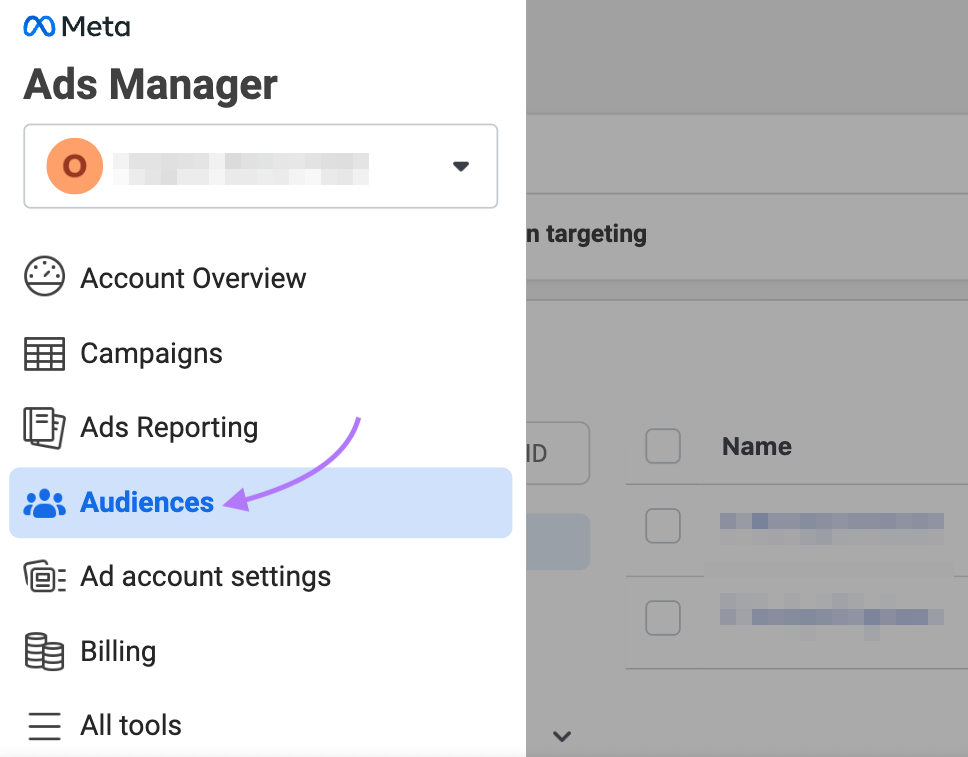
Click on “Create audience” and select “Custom Audience.”
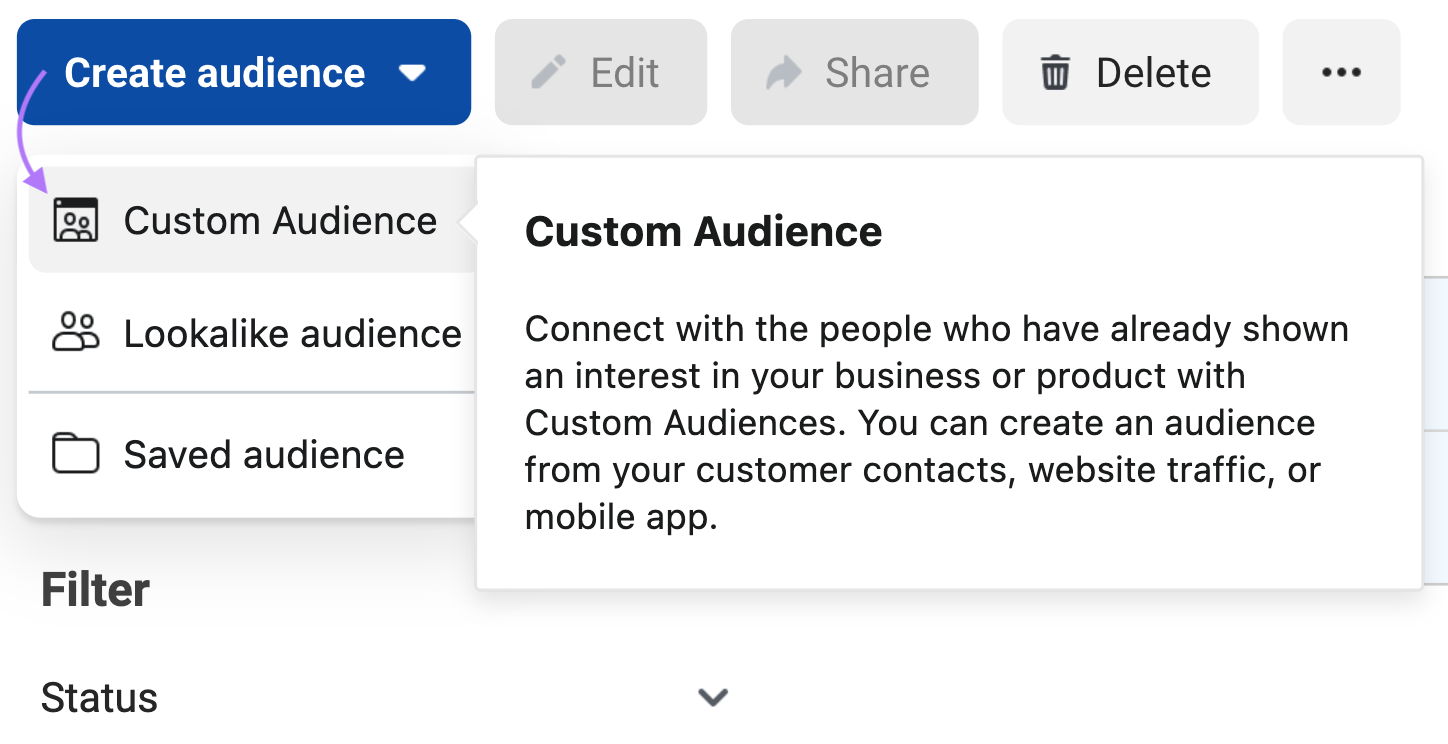
Select “Website” and click “Next.”
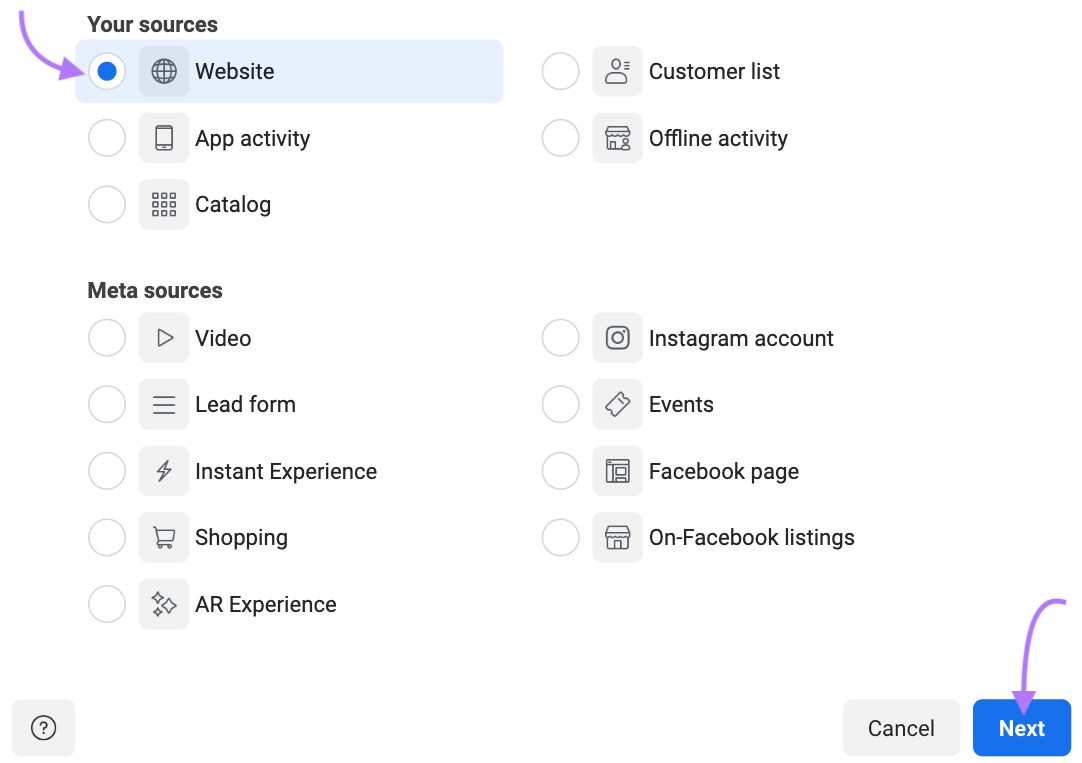
Pick your source website, select whether you want to import all users, and set up retention and inclusion or exclusion criteria.
Then, give your audience a name and description, and click “Create audience.”
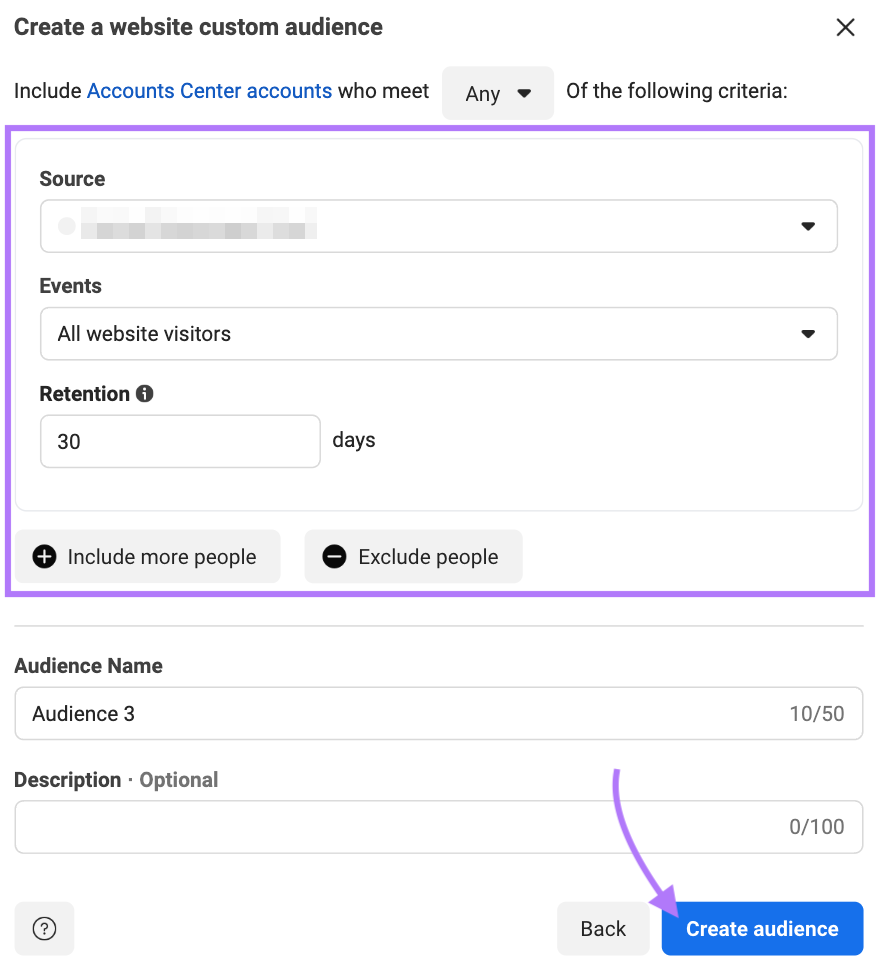
Remember that you can also use the lookalike audience option to generate an audience with similar interests to an existing custom audience you have. Which reduces audience overlap between ad sets.
It’s also important to note that looking into your competitors can be a great way to do audience research. Which you can do using One2Target.
Go to the tool and enter up to five competitors’ domains. And click “Analyze.”
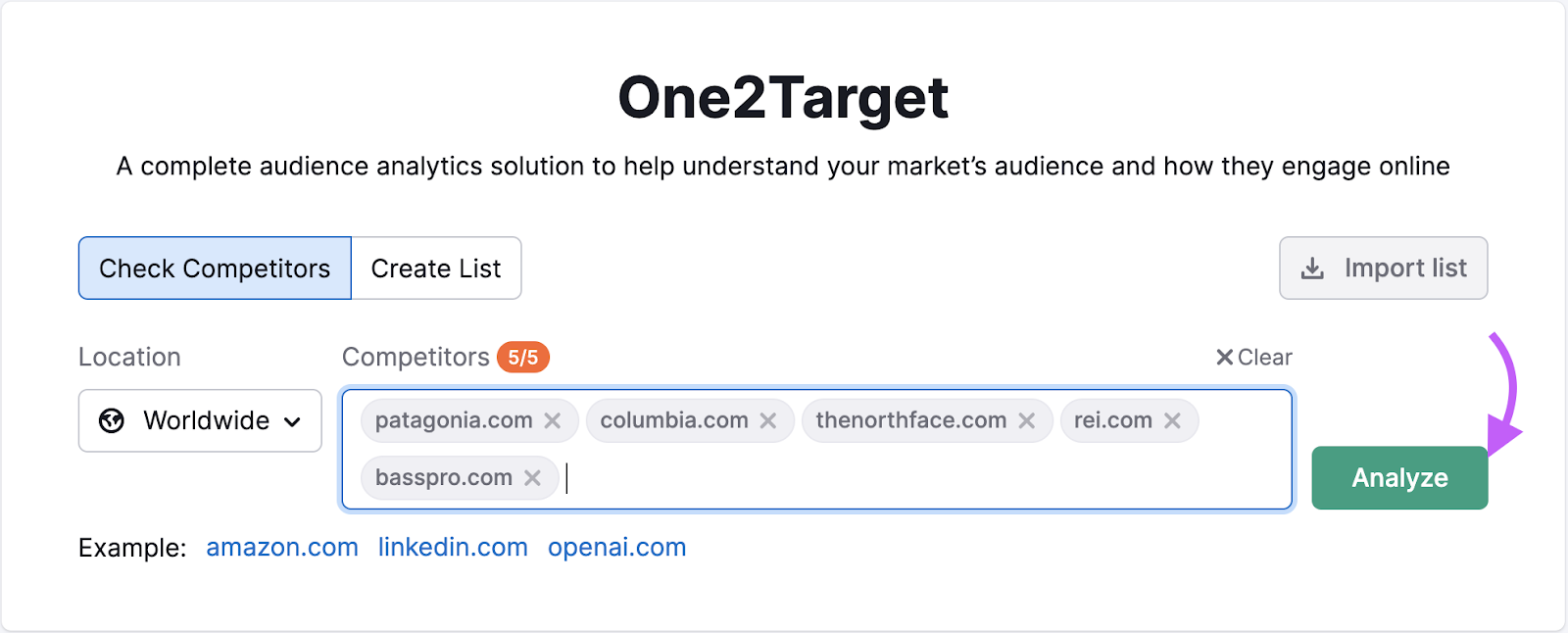
You’ll then be taken to the “Demographics” tab. Where you can see details like the age and country of your competitors’ audiences.
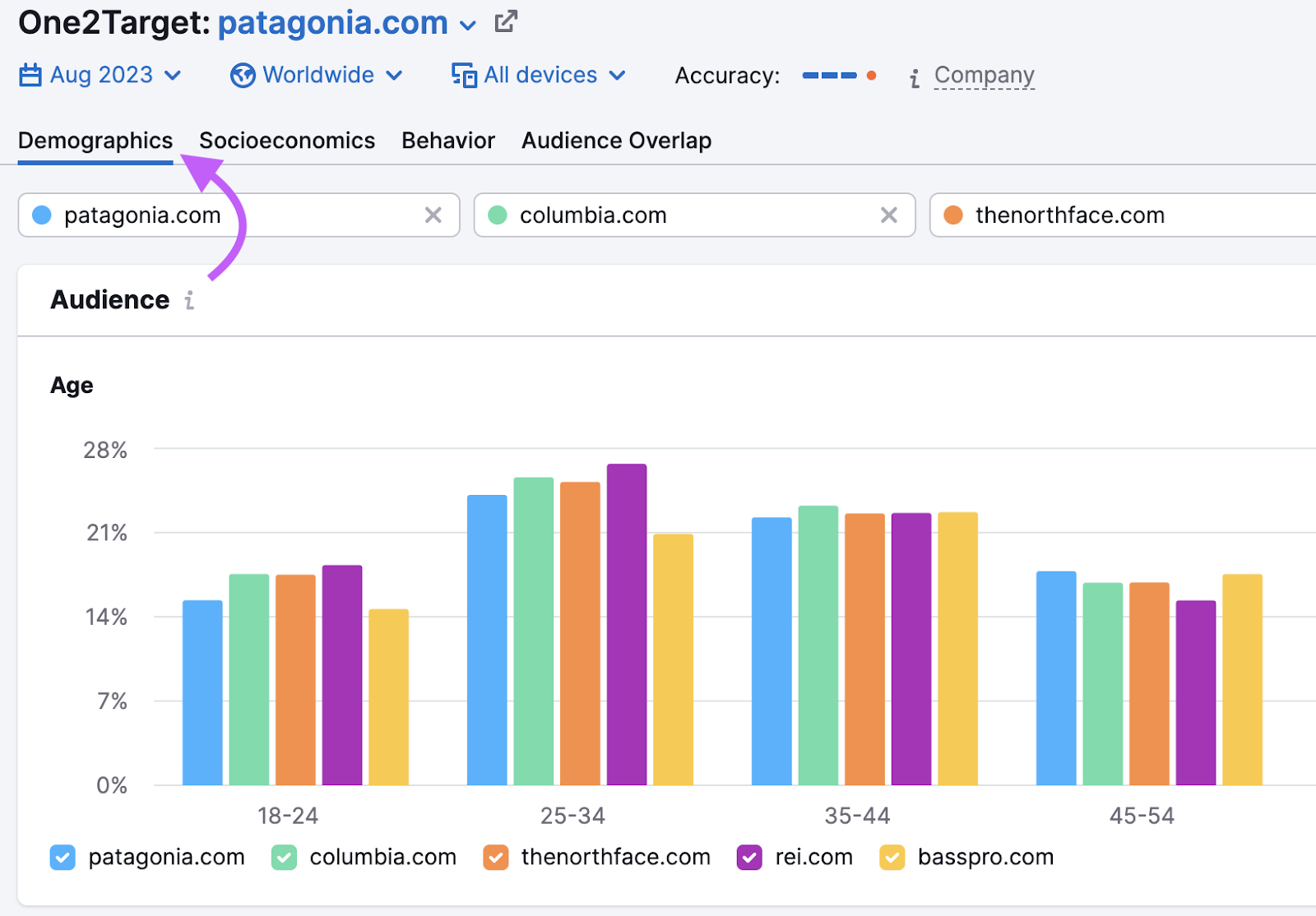
While it’s unlikely you completely missed the mark with your previous ad campaigns, looking at this data can be enlightening. And provide you with ideas for new ways to segment your audience.
Next, click the “Behavior” tab. To see information about the interests and activities your competitors’ audiences engage in.
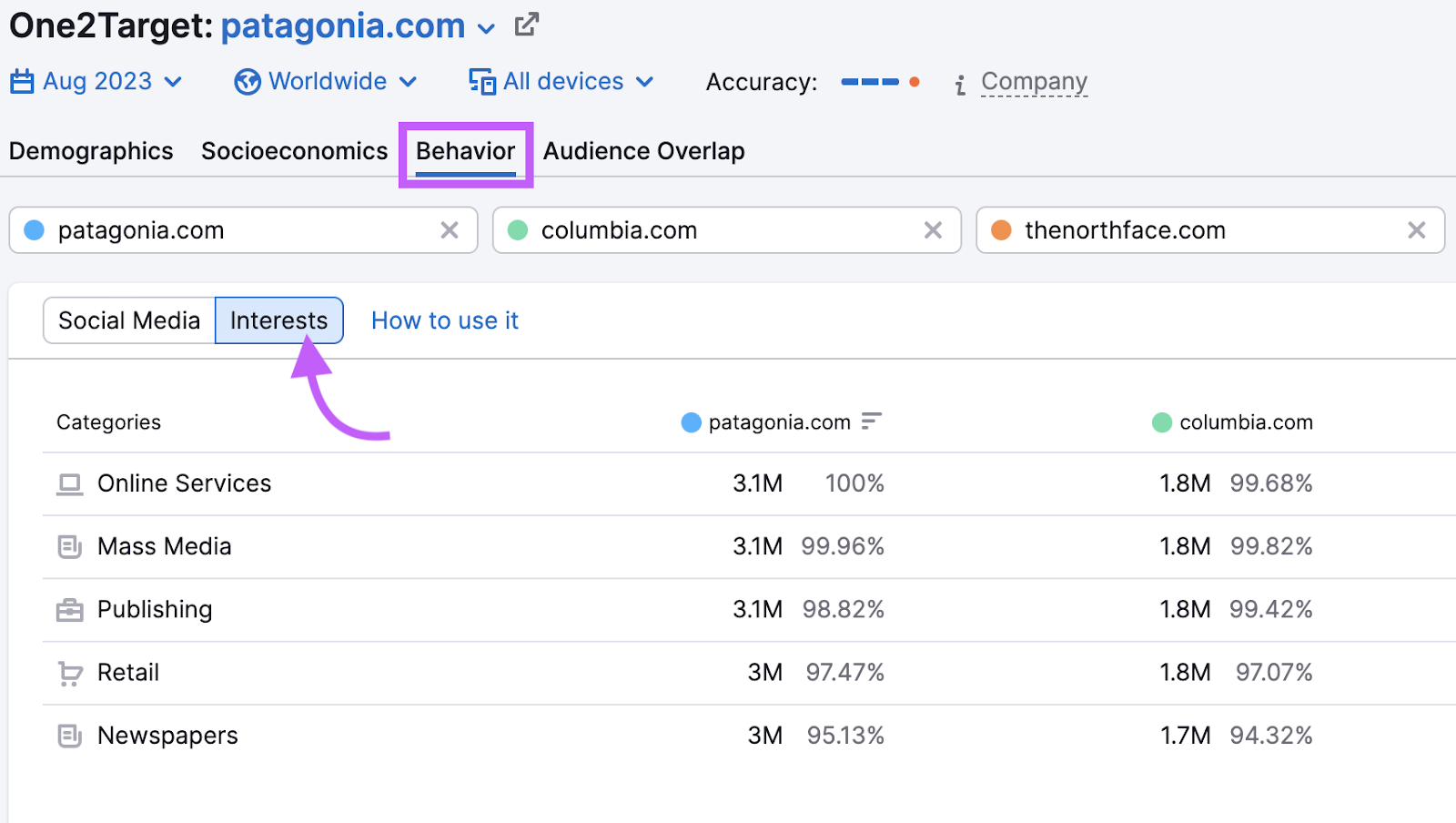
Use Exclusion Targeting
You can use the various exclusion options within Facebook ads manager to remove specific parts of audiences when creating a new ad campaign to reduce the likelihood of overlap.
You can exclude people from previously defined custom audiences (if using the older version of Meta Ads Manager). For Advantage+ users, you can pick from automatically excluding users that may have purchased your product previously or select your own custom audiences.
Many exclusion targeting options require using custom, lookalike, or previously defined audiences.
For users with the original audience options, you can use exclusion options by editing an old campaign or when creating a new one.
In Meta Ads Manager, go to the “Audience” section. Find an existing audience, click on “Edit.”
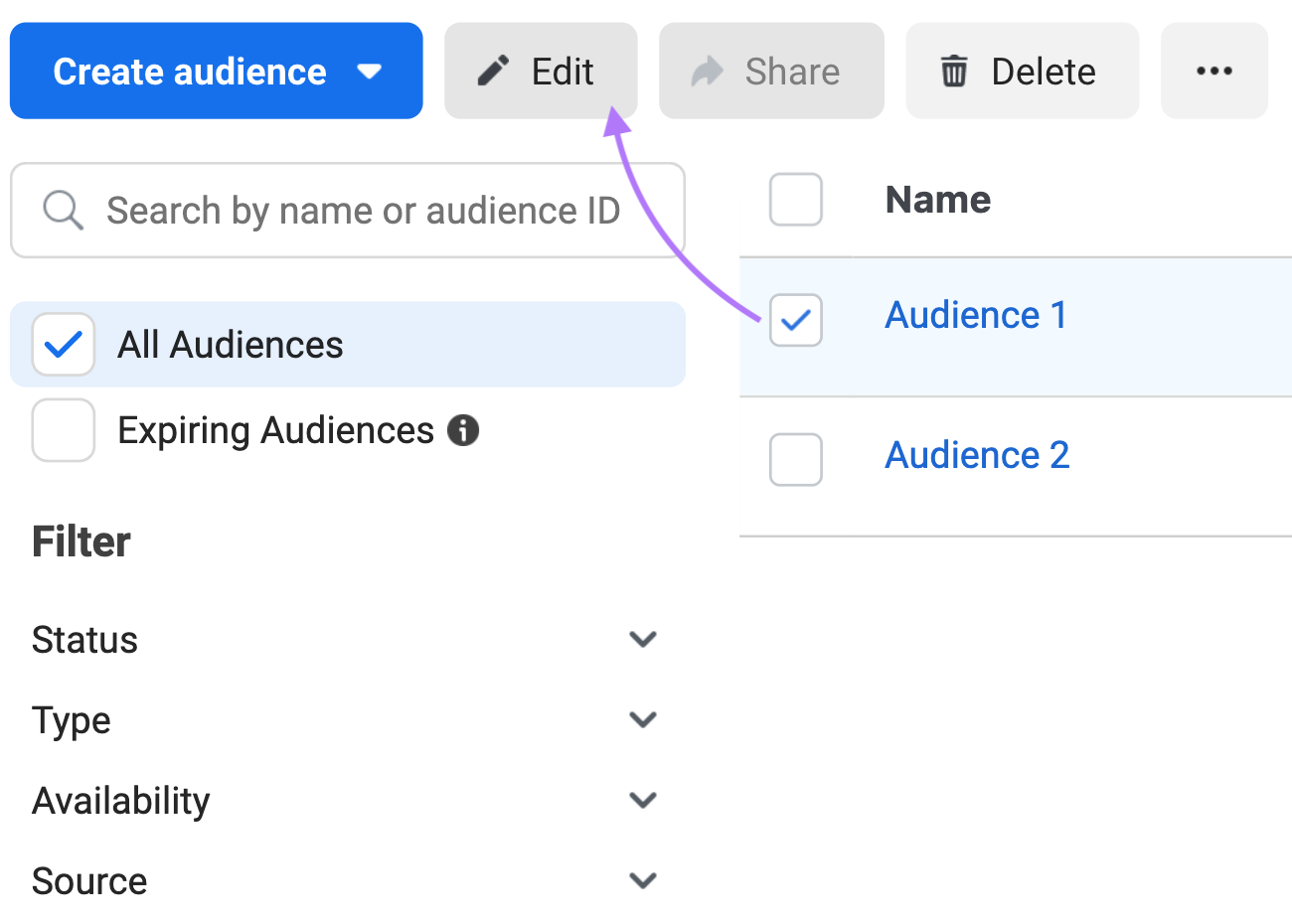
Click on the “Add exclusions” or “Exclude” button to open a new menu.

Then, select a custom audience to exclude under the “Exclude people who are in at least one of the following.”
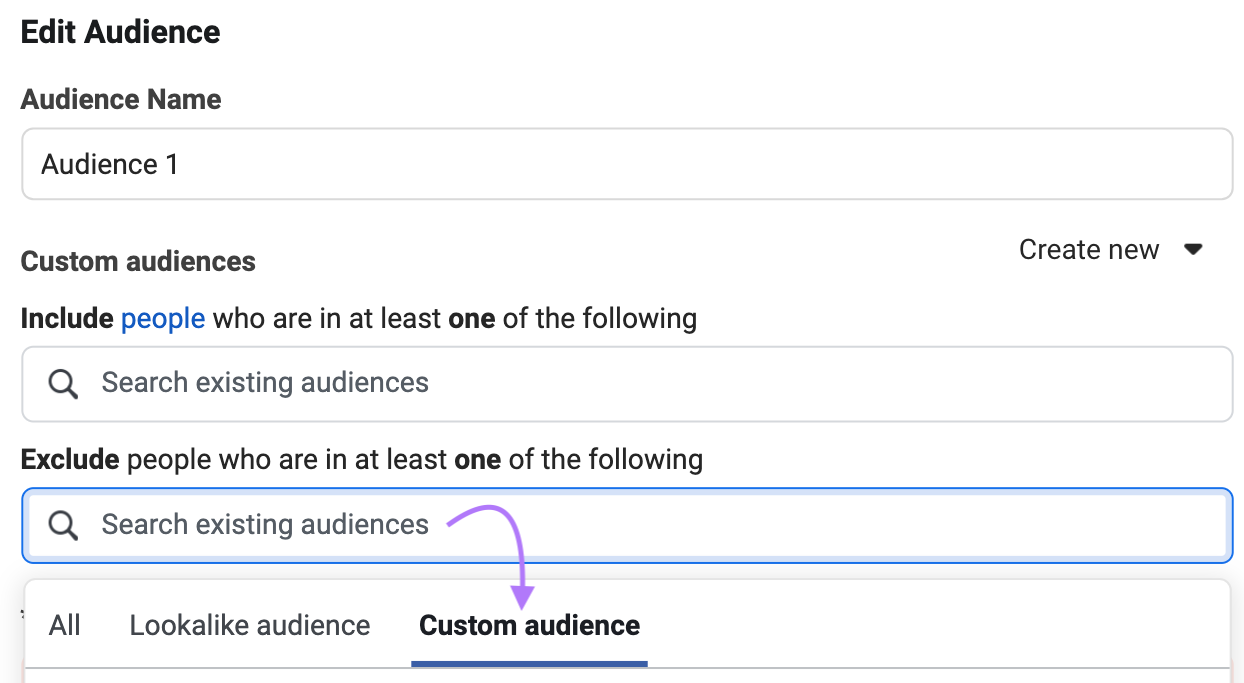
Advantage+ users may be shown a different screen. When creating or editing a campaign, head to the “Audience controls” section, click on “Show more options.”
At the bottom of the section, “Exclude these custom audiences” will become visible.
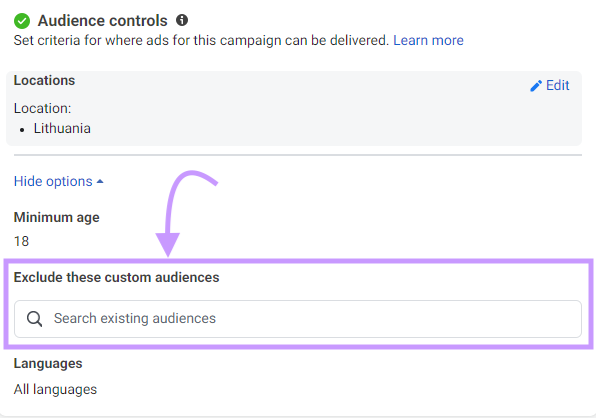
Which audience should you exclude?
Depending on your objective, you may want to exclude website visitors (for awareness), previous customers (for leads and sales), or app users (for app promotion).
You can easily avoid overlap after creating a new ad campaign by checking the overlap with existing campaigns in the audience overlap tool. And excluding the one with the smaller percentage from the one with the higher percentage of overlap.
Experiment with the Frequency Cap
Frequency caps allow you to manually set the number of times an ad is shown to the same person over a specific period of time.
A lower frequency cap will show your ads less frequently but to a larger number of people. And a higher frequency cap will show your ad more frequently but to a smaller number of people.
Choose a lower frequency cap if you want to minimize the effect of audience overlap. Because you’ll have more ad auction opportunities overall.
You can adjust frequency caps for awareness objectives under the “Awareness” section.
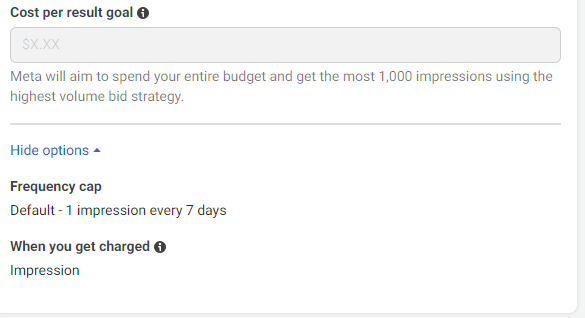
Note: Your frequency cap is closely related to audience size and budget. So, changing frequency caps may not influence results if you have a small budget or narrow audiences.
If you can’t find these options, Meta may not have rolled out these features to your account yet.
Leverage Facebook’s Recommendations
You can use the audience overlap tool to do more than track metrics. In fact, Facebook will display a notification if it considers the level of overlap an issue.
There are two easy solutions to address audience overlap.
First, Facebook may suggest a set of actions that will reduce audience overlap.
These tips will differ according to your unique situation. But you may receive a delivery recommendation, which will include a step-by-step guide.
You can find these delivery recommendations by going to Meta Ads Manager and clicking on “Account Overview.”
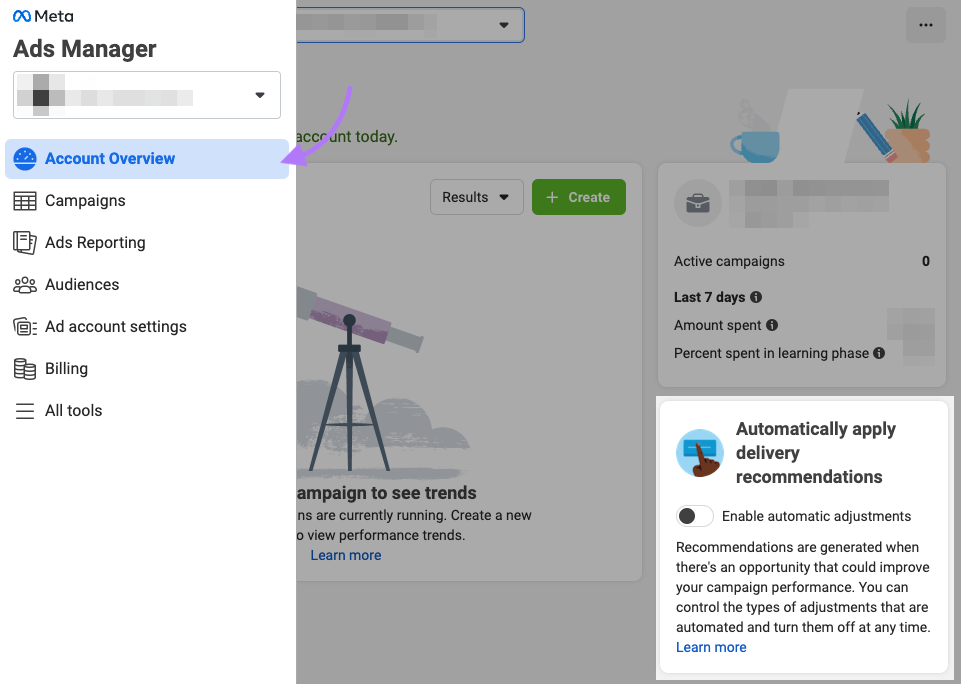
Note: If no delivery recommendations appear, they might not be available to your account. Or you might not have any ad campaigns that can be optimized.
The other option is to merge or turn off overlapping ad sets. Merging sets might negatively affect long-term performance, so it may be safer to turn off one of the ad sets.
Best Practices for Efficient Facebook Ad Targeting
Now that you know how to check for audience overlap on Facebook, use the best practices outlined below to reduce the likelihood that audience overlap ever becomes an issue.
Use Different Ad Formats and Creative Assets for Different Audiences
Whenever you find a new audience segment to market to, think about creating an ad set dedicated to it to minimize the risk of overlap.
Using unique ad sets for each segment may not be necessary. But too many marketers fall into the trap of simply replicating an existing one.
And try performing small tweaks or using different creative assets when marketing to a specific audience segment. Even small changes can make the messaging more attractive to them.
Additionally, make use of the available ad formats and creative options (e.g., videos) to target specific groups and demographics. Don’t be afraid to experiment with GIFs, videos, and various forms of images.
Tip: Avoid using stock photos and images. Most people notice that your brand is using these images, making your ads feel cheap or similar to ones they’ve already seen.
These should be matched according to your target group’s needs and demographics.
For example, millennials and Gen Z might prefer home-quality videos over studio-quality ones, according to Facebook’s own research.
The same research suggests that using real people in your creative may also give a boost to ad performance.
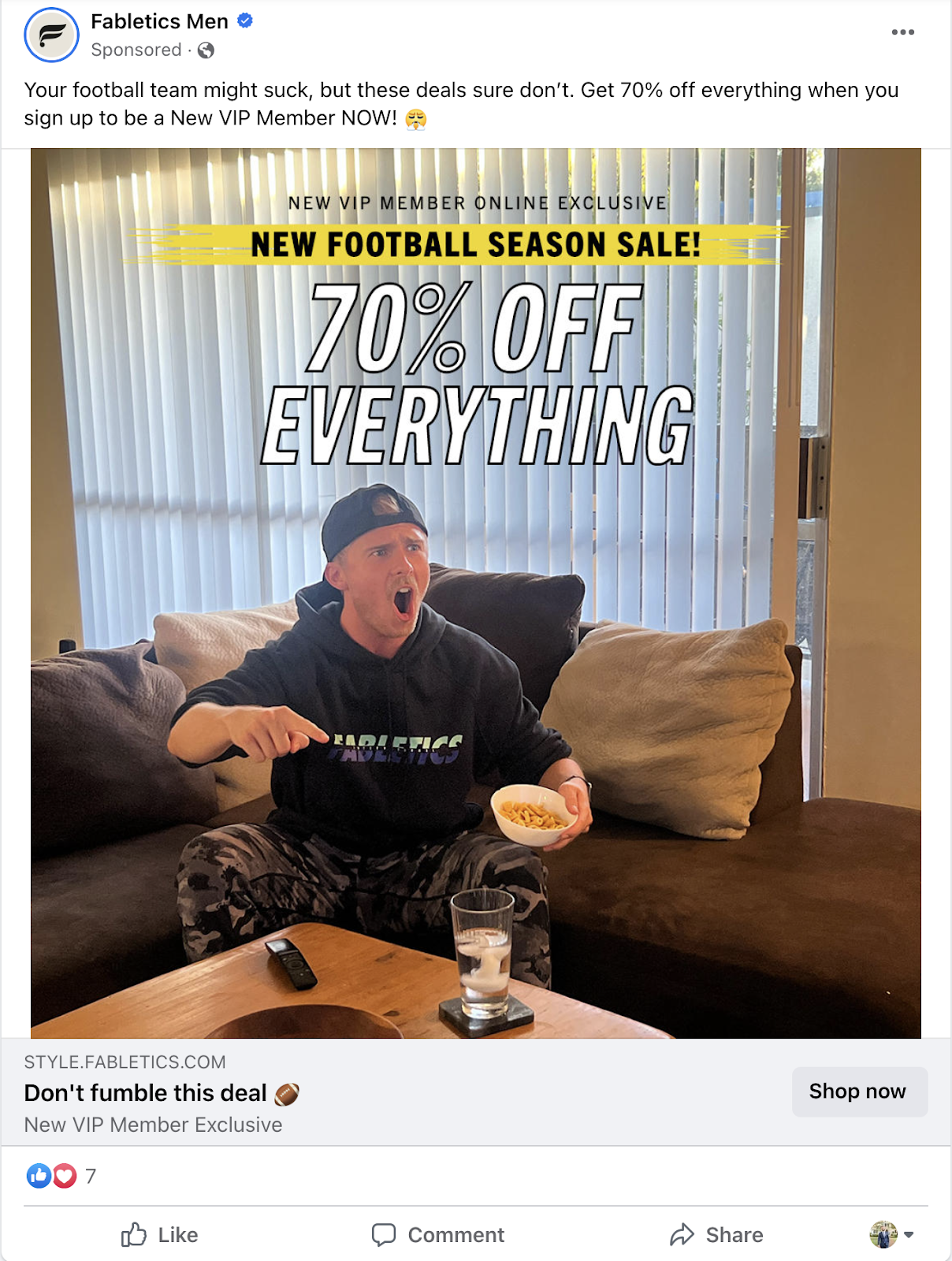
Monitor Ad Performance and Adjust According to Data
Remember to take into account your social media key performance indicators (KPIs). And make changes depending on the results.
Commonly tracked KPIs for Facebook ads include return on ad spend (ROAS), impressions, total cost, and conversion rate.
When overlap is becoming a problem, ROAS and impressions will likely decrease.
One of the best ways to analyze currently running ad campaigns is to have a benchmark based on a few of your previous campaigns. While no two campaigns will ever be the same, a benchmark will give you a measuring stick.
If a new campaign falls below the benchmark for an extended period of time, it’s time to look at the data and make adjustments such as changing audience targeting, creative, or budget.
Test and Iterate Your Campaigns
Make use of the dynamic creative options in the ad campaign section.
Using these options allows you to provide Facebook with up to 10 creative options and up to five headlines and body text variations for each ad set.
They will then alternate and be tested out in practice by Facebook.
Pro tip: Don’t use the max of 10 images/videos for each test campaign. Each option added leeches budget from all other options. If you add more than three options, be prepared to raise your budget to get enough data to get accurate insights into which options are performing best.
After the ad sets have run for some time, you’ll be able to check the performance of all of the versions within your “Campaigns” dashboard.
Simply, select the “Breakdown” drop-down and choose “By Dynamic Creative Element.” Then, choose which element you want to focus on (like the image/video or headline).
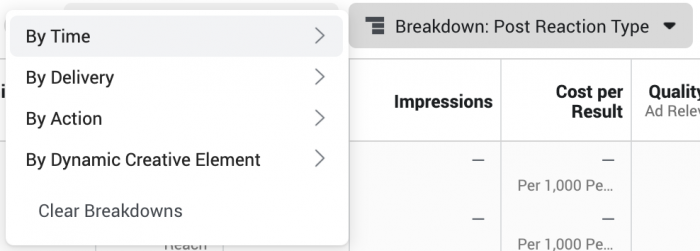
Image Source: Jon Loomer
You’ll notice trends on what works best for your audiences. Like whether you should use long or short headlines, include people in images, etc.
Use these insights to make future campaigns more effective.
Take Control of Your Facebook Advertising Success
Knowing how to see audience overlap for Facebook ads is just a small part of improving your overall Facebook advertising effort.
So, it’s time to go beyond looking at one issue.
And you’ll need more data and precise tools to achieve great results.
Get started by trying out One2Target.
Source link : Semrush.com
